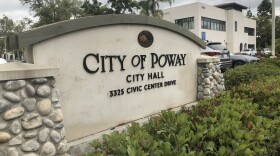Paul Tibbets, the pilot of the B-29 bomber Enola Gay that dropped the atomic bomb on Hiroshima, died Thursday at his home in Columbus, Ohio after suffering a number of health problems. He was 92.
Tibbets, who maintained that he didn't have any regrets about the World War II mission, had been in decline for months.
Tibbets' wishes were not to have a funeral or a headstone. His confidant Gerry Newhouse explained that Tibbets had concerns that his detractors would protest at his gravesite.
It was Aug. 6, 1945, when Tibbets flew the B-29 bomber Enola Gay over the Japanese city of Hiroshima and released a 10,000-pound atomic bomb dubbed "Little Boy."
The blast killed between 70,000 and 100,000 people and injured countless others.
The historic mission was the first use of nuclear weaponry in war.
"We all got ready for the final bomb run," Tibbets told author Bob Greene on National Public Radio's Morning Edition during an interview on Aug. 4, 2000. "I gave them the countdown; I did the seconds. Then, the next thing that happened, the bomb had left the air plane and we all went into a very steep turn — for an airplane of that size and weight in those days at that altitude in particular."
Asked what it felt like when the 5-ton bomb dropped out of the plane, Tibbets said: "The nose lurched up — I mean it lurched dramatically — because if you immediately let 10,000 pounds out of the front, the nose has got to fly up. We made our turn, we leveled out, and at the time that that happened I saw the sky in front of me light up brilliantly with all kinds of colors.
"At the same time I felt the taste of lead in my mouth. And where we had seen the city on the way in, I (now) saw nothing but a bunch of boiling debris with fire and smoke and all of that kind of stuff. It was devastating to take a look at it," Tibbets, who was a 30-year-old colonel when he flew the plane (named in honor of his mother) at 31,000 feet, said during the interview.
Tibbets was told by scientists that the bomb would explode with the equivalent force of 20,000 tons of TNT.
"I figured it would be a real big bang. It sure was. It was surprising," said Tibbets. "I never could have estimated that it would look like it looked."
He had been given the assignment to get the planes ready nearly a year before in September 1944.
"I thought to myself, 'Gee, if we can be successful, we're going to prove to the Japanese the futility in continuing to fight because we can use those weapons on them. They're not going to stand up to this thing. After I saw what I saw I was more convinced that they're gonna quit. That's the only way I could do it,'" he told Morning Edition.
Three days after Hiroshima, the United States let loose a second nuclear bomb over Nagasaki, Japan, killing an estimated 40,000 people. Tibbets did not fly in that mission.
The Japanese surrendered a few days later, ending the war.
Tibbets never expressed regret, viewing the assignment as his patriotic duty.
Born Feb. 23, 1915, in Quincy, Ill., Tibbets spent most of his boyhood in Miami.
He was a student at the University of Cincinnati's medical school when he decided to withdraw in 1937 to enlist in the Army Air Corps.
He retired from the Air Force as a brigadier general in 1966. He later moved to Columbus, where he ran an air-taxi service until he retired in 1985.
But his role in the bombing brought him fame — and infamy — throughout his life.
In 1976, he was criticized for reenacting the bombing during an appearance at a Harlingen, Texas, air show. As he flew a B-29 Superfortress over the show, a bomb set off on the runway below created a mushroom cloud.
He said the display "was not intended to insult anybody," but the Japanese were outraged. The U.S. government later issued a formal apology.
Tibbets again defended the bombing in 1995, when an outcry erupted over a planned 50th anniversary exhibit of the Enola Gay at the Smithsonian Institution.
From NPR reports and The Associated Press
Copyright 2022 NPR. To see more, visit https://www.npr.org. 9(MDAzMjM2NDYzMDEyMzc1Njk5NjAxNzY3OQ001))





